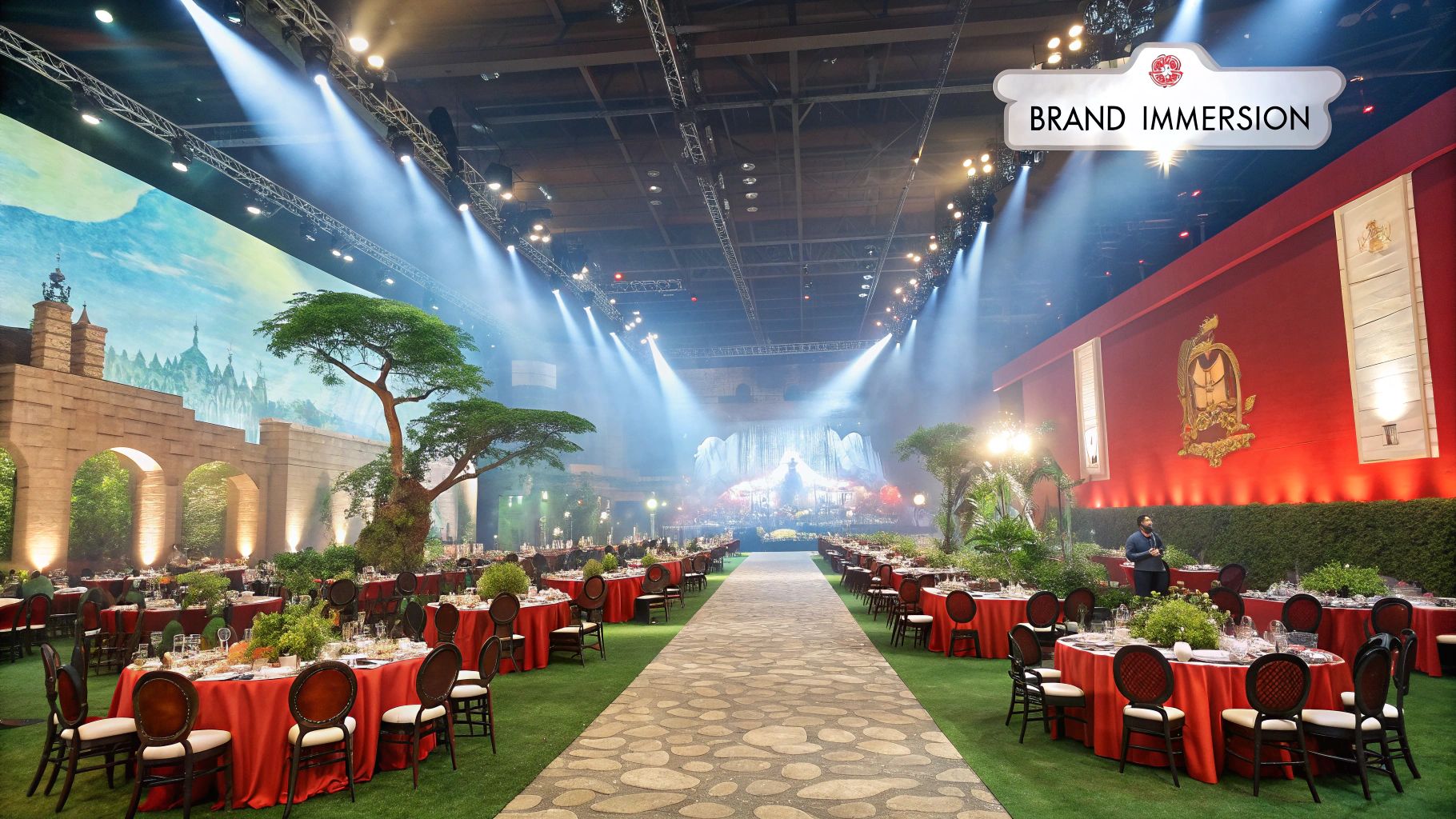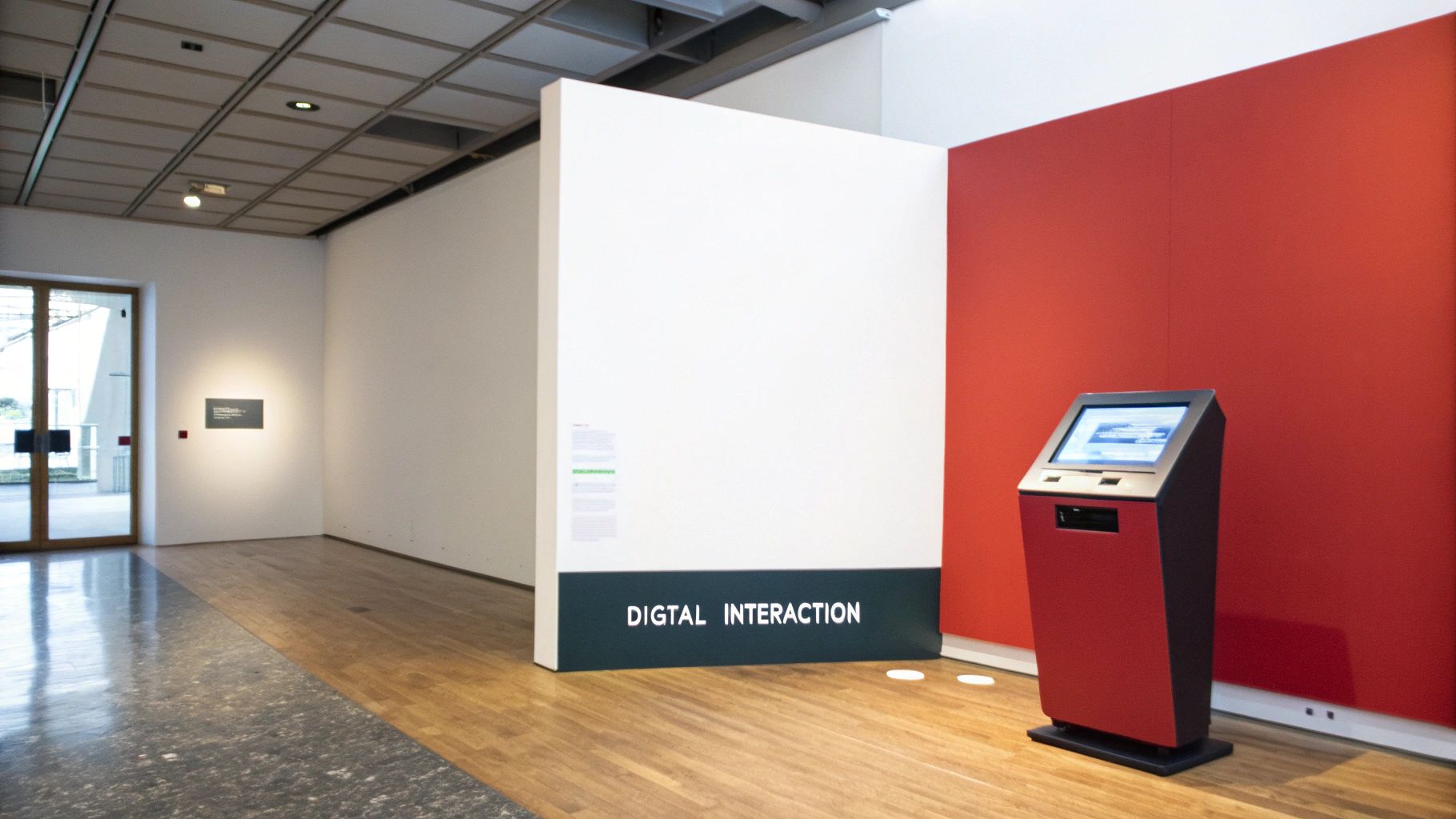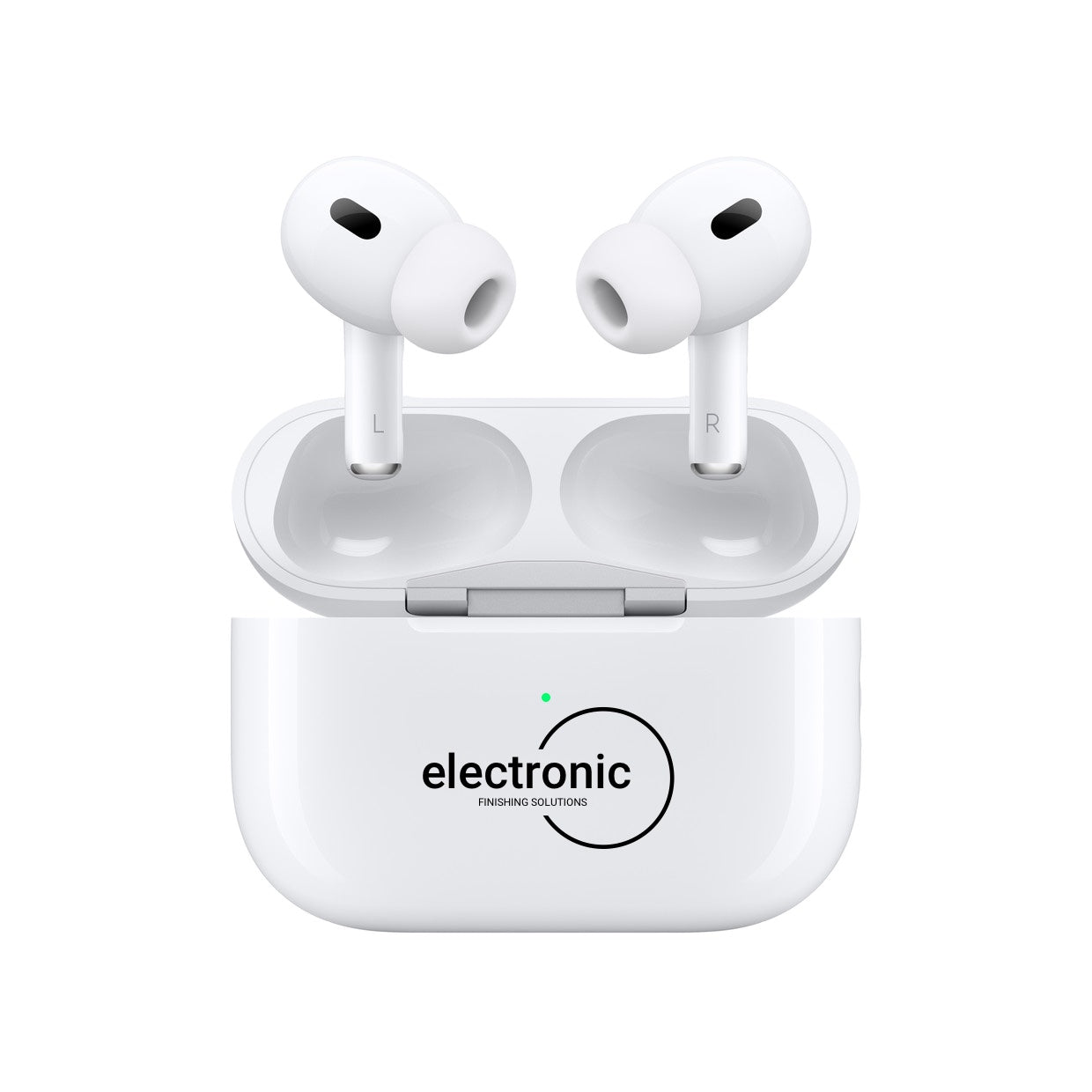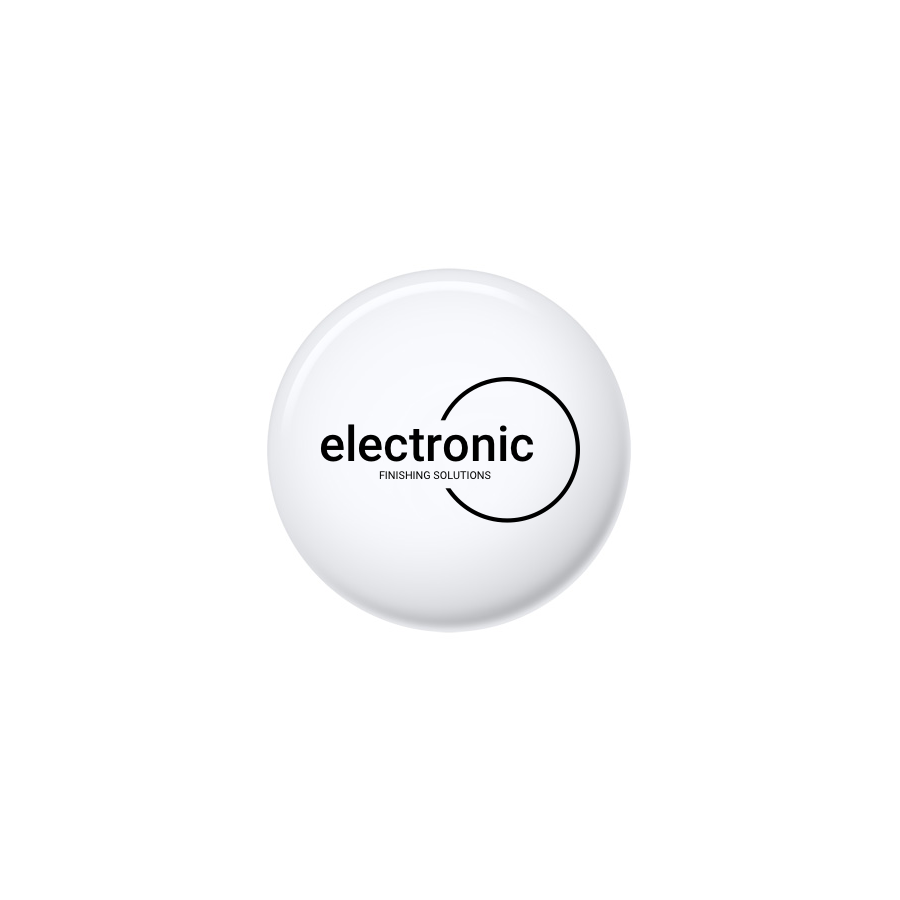Unforgettable Event Branding: Making Your Mark in 2025
Want to create truly unforgettable events? Event branding is key. A well-branded event doesn't just impress attendees; it strengthens your brand and amplifies your message.
This listicle delivers 10 cutting-edge event branding ideas for 2025 and beyond. We'll explore innovative strategies and actionable takeaways to make your next gathering a resounding success. From immersive themed environments to personalized experiences, these ideas go beyond the surface, adding depth and impact to your events. Learn how to:
- Design immersive themed environments that transport attendees
- Leverage interactive digital installations for engagement
- Craft a sensory experience that resonates with your brand
- Integrate storytelling into the attendee journey
These event branding ideas are designed for conferences, trade shows, product launches, and VIP experiences. This curated collection will help Fortune 100 companies, tech startups, corporate marketing teams, venture capital firms, and event coordinators alike. Let's explore the exciting possibilities of 2025 event branding.
1. Immersive Themed Environments
Transform your event into an unforgettable experience with an immersive themed environment. This event branding idea goes beyond simple decoration; it's about creating a cohesive, sensory experience that transports attendees to another world. This approach completely reimagines the event space through detailed set design, targeted lighting, strategic prop placement, and atmospheric elements, all meticulously aligned with your brand's message or event purpose.

Think of the creative studio environments at Adobe Max, the desert bohemian aesthetic of Coachella, or the pop culture immersion of Comic-Con. Even high-end product launches, like those orchestrated by Apple, leverage immersive environments to build anticipation and create a buzz. These examples demonstrate the power of themed environments to generate excitement and deeply engage attendees. When considering how to brand your event space for maximum impact, check out resources like this one for additional stage design inspiration: Stunning Stage Design Ideas for Corporate Events 2025 It features some great ideas from 8 Stunning Stage Design Ideas for Corporate Events 2025 from Gearsupply.
Tips for Creating Immersive Experiences:
- Plan Early: Begin planning at least six months in advance to allow ample time for design, procurement, and execution.
- Visualize the Atmosphere: Develop a detailed mood board to solidify your vision and ensure consistent execution across all design elements.
- Prioritize Lighting: Lighting plays a crucial role in setting the atmosphere. Consider it as 50% of the overall immersive experience.
- Encourage Interaction: Incorporate interactive elements to enhance engagement and create memorable moments for attendees.
- Photo Opportunities: Designate specific photo areas with optimal lighting for shareable social media content. This organically extends your event's reach.
This event branding idea offers a powerful way to differentiate your event, reinforce your brand message, and leave a lasting impression. By carefully crafting a unique world within your event space, you enhance engagement, encourage social sharing, and offer attendees an unforgettable brand experience.
2. Interactive Digital Installations
Transform your event branding with interactive digital installations. These technology-driven experiences allow attendees to engage with digital content through touchscreens, augmented reality, motion sensors, or mobile apps. This creates personalized, engaging experiences while simultaneously collecting valuable attendee data and fostering memorable brand interactions. These installations can range from simple touch screen kiosks to complex augmented reality experiences.

Think of Nike's interactive shoe customization stations, Coca-Cola's personalized bottle vending machines, or IBM Watson's AI-powered event interactions. Microsoft also regularly uses HoloLens demonstrations at tech conferences to create buzz and showcase cutting-edge technology. These examples highlight the power of digital installations to create memorable event branding experiences. For more virtual event engagement inspiration, learn more about engaging a virtual audience.
Tips for Implementing Interactive Digital Installations:
- Technical Backup: Always have backup systems and contingency plans in place to address potential technical issues.
- Thorough Testing: Test all technology extensively before the event to ensure smooth operation and avoid glitches.
- Clear Instructions: Provide clear instructions and readily available staff assistance to guide attendees through the interactions.
- Fast Loading Times: Ensure fast loading times and responsive interfaces to maintain attendee engagement and prevent frustration.
- Social Sharing: Integrate social sharing capabilities to encourage attendees to share their experiences and extend your event's reach.
Interactive digital installations offer a powerful way to elevate your event branding. By leveraging technology to create personalized and engaging experiences, you collect valuable data, boost brand interaction, and leave a lasting impression on attendees. This makes digital installations a perfect fit for tech product launches, conferences, and trade shows aiming to attract a tech-savvy audience.
3. Signature Color Psychology Branding
Transform your event's atmosphere and reinforce your brand message with signature color psychology branding. This event branding idea leverages the emotional impact of color to create mood-specific environments aligned with your event's objectives. It goes beyond simply using your standard brand colors; it's about strategically selecting palettes that evoke specific emotional responses from attendees, enhancing the overall brand experience.

Think of Tiffany & Co.'s iconic robin's egg blue, evoking luxury and exclusivity, or Spotify's vibrant green, synonymous with energy and innovation. Even corporate giants like UPS leverage their signature brown in event branding, reinforcing their reliability and trustworthiness. These examples highlight how color can be a powerful tool in shaping attendee perception and reinforcing brand identity. Want to give attendees branded gifts in your signature color scheme? Learn more about event giveaway ideas to enhance the experience.
Tips for Effective Color Psychology Branding:
- Research Color Psychology: Understand the cultural and emotional connotations of colors for your target audience.
- Test Lighting Conditions: Colors appear different under various lighting. Test your chosen palette in your event space.
- 60-30-10 Rule: Use this design principle for color distribution: 60% dominant color, 30% secondary color, 10% accent color.
- Colorblind Accessibility: Consider attendees with colorblindness and ensure your color choices are inclusive.
- Color Usage Guide: Create a comprehensive guide for vendors to ensure consistent color implementation across all event elements.
This event branding idea provides a subtle yet powerful way to influence attendee mood and perception. By strategically utilizing color psychology, you can create a more impactful and memorable event experience that aligns seamlessly with your brand identity and event goals.
4. Sensory Branding Experiences
Elevate your event branding with a multi-sensory experience that captivates attendees on a deeper level. Sensory branding engages all five senses - sight, sound, smell, taste, and touch - to create memorable and emotional connections with your brand. This approach leverages the science of sensory memory to enhance brand recall and strengthen associations. It transforms a standard event into a rich, immersive experience.

Think of Abercrombie & Fitch's signature store scent, the enticing aroma of Dunkin' Donuts coffee marketing in Korea, or Singapore Airlines' distinctive scent program. Even the tactile experience of Rolls-Royce's leather and wood interiors demonstrates the power of sensory branding. These examples highlight how engaging multiple senses creates a lasting impression. Choosing the right colors can significantly impact brand perception; consider how color psychology can play a role. This insightful resource from 10 Winning Color Combinations for Logos in 2025 from Creativize offers valuable guidance.
Tips for Creating Sensory Experiences:
- Map the Sensory Journey: Plan the attendee experience from arrival to departure, considering how each sense will be engaged at every touchpoint.
- Test and Refine: Conduct focus groups to test sensory elements and ensure they resonate with your target audience. Gather feedback and adjust accordingly.
- Cultural Sensitivity: Be mindful of cultural preferences and sensitivities related to scents, tastes, and other sensory elements. Offer options to accommodate diverse needs.
- Document Successful Combinations: Keep records of sensory combinations that prove effective. This creates a valuable resource for future events and brand consistency.
Sensory branding offers a powerful way to create truly unforgettable event experiences. By carefully orchestrating sensory elements, you can forge deeper emotional connections with attendees, enhance brand recall, and leave a lasting positive impression. This event branding idea is particularly impactful for product launches, VIP experiences, and events aiming to create a premium brand perception.
5. Storytelling Through Branded Journeys
Transform your event into an interactive narrative with storytelling through branded journeys. This event branding idea crafts a cohesive brand story, revealed progressively as attendees move through different event areas or activities. Each touchpoint acts as a chapter, unfolding the narrative and immersing attendees in a compelling brand experience. This approach elevates events from passive gatherings to dynamic storytelling platforms.
Think of Nike's athlete journey experiences at major sporting events, where attendees trace the path of an athlete from training to victory. Disney masterfully integrates its brand story into corporate events, immersing attendees in the magic of their storytelling legacy. Red Bull's adventure narrative in extreme sports events reinforces their brand's association with risk-taking and pushing boundaries. Even Patagonia leverages environmental storytelling in retail events, connecting with their audience's values. These examples showcase the power of narrative-driven experiences to engage attendees on an emotional level.
Tips for Crafting Branded Journeys:
- Create Clear Navigation: Use clear signage and wayfinding elements to guide attendees through the narrative journey.
- Train Staff as Story Facilitators: Equip your staff to answer questions and enhance the storytelling experience.
- Design Flexible Entry Points: Accommodate attendees arriving at different times with multiple entry points into the narrative.
- Include Takeaway Elements: Provide keepsakes that extend the story beyond the event, reinforcing key messages.
- Use Technology to Enhance Narrative: Incorporate interactive technology to deepen immersion and personalize the journey.
Storytelling through branded journeys offers a powerful way to connect with your audience, reinforcing brand values and creating memorable experiences. By turning your event into an interactive story, you foster deeper engagement and leave a lasting impression long after the event concludes. This approach is particularly effective for brands with a strong heritage or mission, allowing them to share their story in a dynamic and engaging way.
6. Sustainable and Eco-Conscious Branding
Elevate your event's impact by embracing sustainable and eco-conscious branding. This event branding idea prioritizes environmental responsibility without compromising brand messaging. It involves incorporating eco-friendly materials, implementing waste reduction strategies, and promoting green initiatives. This approach resonates with environmentally conscious audiences and demonstrates your commitment to a healthier planet.
Salesforce's carbon-neutral Dreamforce conference, Patagonia's zero-waste retail events, and IKEA's circular economy product launches showcase the effectiveness of this approach. These brands successfully integrate sustainability into their events, attracting attendees who share these values. Learn more about boosting your brand with sustainable promotional items: Learn more about boosting your brand with sustainable promotional items. Ben & Jerry's climate action campaign events further exemplify this trend, demonstrating its versatility across industries.
Tips for Implementing Sustainable Practices:
- Partner with Sustainable Vendors: Collaborate with suppliers who offer eco-friendly materials and prioritize sustainable practices.
- Communicate Sustainability Efforts: Clearly inform attendees about your event's sustainability initiatives and encourage their participation.
- Measure and Report Environmental Impact: Track your event's environmental footprint and share your progress transparently.
- Provide Recycling and Composting Stations: Facilitate waste reduction by providing readily accessible recycling and composting options.
- Choose Green Certified Venues: Select venues with established green certifications, demonstrating your commitment to sustainability.
This event branding idea not only minimizes environmental impact but also enhances your brand image. By showcasing your commitment to sustainability, you attract environmentally conscious attendees, generate positive PR, and contribute to a more sustainable future. This approach is particularly relevant for brands targeting younger demographics and those in industries with a strong focus on environmental responsibility.
7. Personalized Individual Experiences
Transform your event into a truly unique experience for each attendee with personalized individual experiences. This event branding idea leverages technology and data analytics to tailor content, recommendations, and interactions based on individual attendee preferences, behaviors, and data. This approach moves beyond the one-size-fits-all model to create bespoke experiences that resonate on a personal level.
Think of Spotify Wrapped experiences brought to life, the curated product showcases at Amazon's physical stores, or LinkedIn's tailored networking suggestions at conferences. These examples highlight the power of personalization to foster deeper engagement. Netflix also utilizes personalized content previews to generate excitement for upcoming releases, demonstrating the versatility of this approach across various event types. This level of customization creates a sense of exclusivity and value, making attendees feel seen and appreciated.
Tips for Creating Personalized Experiences:
- Obtain Explicit Consent: Always obtain explicit consent for data collection and usage. Transparency builds trust.
- Provide Opt-Out Options: Offer attendees clear and easy opt-out options for personalization. Respecting individual preferences is key.
- Ensure Data Security: Prioritize data security and comply with all relevant privacy regulations. Protecting attendee information is paramount.
- Test Thoroughly: Test personalization algorithms thoroughly to ensure accuracy and avoid unintended biases.
- Non-Personalized Backup: Have non-personalized backup experiences ready in case of technical glitches or attendee opt-outs.
This event branding idea offers a potent way to elevate attendee engagement and create lasting impressions. By tailoring the event experience to individual preferences, you demonstrate a commitment to attendee satisfaction, which can lead to increased brand loyalty and advocacy. This approach is particularly relevant for events focused on networking, product demonstrations, or content showcases, where personalized recommendations can significantly enhance the attendee journey.
8. Collaborative and Co-Creation Branding
Transform your event into a dynamic brand-building experience with collaborative and co-creation branding. This event branding idea shifts attendees from passive observers to active participants, inviting them to contribute to the brand narrative. By involving them in creating content, experiences, or even products, you foster a stronger emotional connection and generate authentic brand advocacy. This fosters a sense of ownership and community among attendees, transforming them into enthusiastic brand ambassadors.
Think of LEGO's Master Builder workshops, where attendees create unique LEGO builds, or Adobe's creative challenges at design conferences. Nike's custom shoe design stations and Starbucks' community art projects also exemplify this approach. These activations demonstrate how co-creation can transform an event from a presentation into a shared experience. To enhance individual experiences at your event, explore strategies related to personalized video marketing from Master Personalized Video Marketing Strategies that Convert from VideoQi. This can add a tailored touch to the co-creation process.
Tips for Collaborative Branding:
- Provide Clear Guidelines: Offer clear instructions and boundaries for co-creation activities to ensure a positive and productive experience.
- Skilled Facilitators: Employ experienced facilitators to guide participants, manage activities, and foster creativity.
- Easy Sharing Mechanisms: Implement simple ways for attendees to share their creations on social media, extending your event's reach organically.
- Showcase Contributions: Display and celebrate participant creations prominently at the event to reinforce the collaborative spirit and acknowledge contributions.
- Post-Event Follow-Up: Maintain the connection by following up with participants after the event, sharing highlights, and showcasing their work.
This event branding idea offers a powerful way to cultivate a sense of shared ownership, amplify your brand message through authentic voices, and transform attendees into passionate brand advocates. By creating opportunities for meaningful contribution, you enhance engagement, generate buzz, and leave a lasting impact that extends far beyond the event itself.
9. Hyper-Local Cultural Integration
Infuse your event branding with the spirit of the locale by embracing hyper-local cultural integration. This event branding idea moves beyond generic theming to authentically reflect the host city's distinct character. By weaving local traditions, art, cuisine, and community elements into your event experience, you create a truly memorable experience that resonates deeply with attendees and fosters genuine connections with the local community. This approach respects the local culture while enhancing your brand narrative.
Think of McDonald's integrating local flavors into their menus worldwide, or Airbnb offering neighborhood-specific experiences. These examples showcase how incorporating local nuances can enhance a brand's appeal. Coca-Cola's culturally tailored campaigns and Google's local language integration in events further demonstrate this strategy's effectiveness. Consider offering promotional items relevant to the area, like those available at Electronic Finishing's New York location, for a tangible example of hyper-local integration.
Tips for Authentic Cultural Integration:
- Thorough Research: Deeply research local customs, traditions, and sensitivities to avoid misrepresentation or cultural appropriation.
- Local Partnerships: Collaborate with respected local cultural organizations and community leaders for guidance and authentic representation.
- Local Talent: Showcase local artists, musicians, and performers to enrich the event experience and support the local economy.
- Brand Enhancement: Ensure that local elements complement and enhance your brand message, rather than overshadowing it.
- Cultural Consultants: Engage local cultural consultants to ensure respectful and accurate representation of cultural elements.
Hyper-local cultural integration transforms your event from a generic gathering into a celebration of the host community. This approach demonstrates respect for local culture, enhances brand perception, and provides attendees with a unique, authentically local experience. It's an ideal event branding idea for companies expanding into new markets, tourism ventures, and organizations seeking to create meaningful connections within a community. This method differentiates your event, fostering genuine engagement and leaving a positive lasting impression.
10. Gamification and Competition Elements
Transform your event into an engaging experience by incorporating gamification and competition elements. This event branding idea leverages the psychological drivers of achievement and competition to enhance brand interaction. By integrating game mechanics, competitive elements, and achievement systems, you can encourage specific behaviors and create memorable interactive experiences. This approach moves beyond passive participation, turning attendees into active players.
Think of Salesforce's Trailhead gamified learning platform at Dreamforce, or Nike Run Club's competitive running events. LinkedIn's networking challenge games and Microsoft's developer competition events further illustrate how this approach can boost engagement and create a buzz. These examples demonstrate the power of gamification to draw attendees into the brand experience.
Tips for Implementing Gamification:
- Align with Objectives: Design games that directly support your event objectives, whether it's networking, learning, or product discovery.
- Ensure Fair Play: Establish clear competition rules and ensure proper monitoring to maintain fairness and integrity.
- Offer Options: Provide both individual and team-based competition options to cater to different preferences and group dynamics.
- Meaningful Rewards: Offer valuable prizes and recognition to motivate participation and acknowledge achievement.
- Inclusive Participation: Include non-competitive participation options to ensure that all attendees can engage at their comfort level.
This event branding idea offers a dynamic way to boost attendee engagement, reinforce brand messaging, and collect valuable data on attendee behavior. By strategically integrating game mechanics and competition, you can create a more interactive, memorable, and impactful event experience. Gamification provides a fresh and engaging way to stand out and make a lasting impression on attendees.
Top 10 Event Branding Ideas Comparison
| Branding Strategy | Implementation Complexity 🔄 | Resource Requirements ⚡ | Expected Outcomes 📊 | Ideal Use Cases 💡 | Key Advantages ⭐ |
|---|---|---|---|---|---|
| Immersive Themed Environments | High 🔄🔄🔄 | High ⚡⚡⚡ | Strong brand recall, emotional impact 📊📊 | Large-scale branded events, product launches | Memorable & shareable experiences, full immersion ⭐⭐ |
| Interactive Digital Installations | Medium-High 🔄🔄 | High ⚡⚡ | High engagement, measurable ROI 📊📊 | Tech events, data-driven activations | Personalized interaction, real-time analytics ⭐⭐ |
| Signature Color Psychology Branding | Medium 🔄🔄 | Low ⚡ | Strong emotional connection 📊 | Brand consistency, environment mood setting | Cost-effective, cohesive brand experience ⭐ |
| Sensory Branding Experiences | High 🔄🔄🔄 | Medium-High ⚡⚡ | Strongest memory associations 📊📊📊 | Luxury brands, hospitality, retail spaces | Deep emotional engagement, multi-sensory impact ⭐⭐ |
| Storytelling Through Branded Journeys | High 🔄🔄🔄 | Medium-High ⚡⚡ | Emotional investment, shareability 📊📊 | Narrative-focused events, immersive brand stories | Encourages full participation, word-of-mouth ⭐⭐ |
| Sustainable and Eco-Conscious Branding | Medium 🔄🔄 | Medium ⚡⚡ | Positive brand image, cost savings 📊 | Environmentally conscious brands/events | CSR demonstration, attracts sustainability-minded ⭐ |
| Personalized Individual Experiences | High 🔄🔄🔄 | High ⚡⚡⚡ | Increased satisfaction and loyalty 📊📊 | Data-driven events, VIP and personalized experiences | Enhanced brand value, detailed customer insights ⭐ |
| Collaborative and Co-Creation Branding | Medium-High 🔄🔄 | Medium-High ⚡⚡ | Authentic content, emotional connection 📊 | Community-driven events, creative workshops | Builds brand advocacy, high engagement ⭐ |
| Hyper-Local Cultural Integration | Medium-High 🔄🔄 | Medium ⚡⚡ | Authentic local connections 📊 | Multi-location/global events, culturally focused | Builds respect & unique experiences ⭐ |
| Gamification and Competition Elements | Medium 🔄🔄 | Medium-High ⚡⚡ | Increased participation, measurable metrics 📊 | Engagement-driven events, training & networking | Boosts engagement, encourages behaviors ⭐ |
Elevating Your Brand Through Exceptional Events
This curated collection of event branding ideas has explored ten powerful strategies to transform ordinary events into extraordinary brand experiences. From immersive themed environments and interactive digital installations to the subtle power of signature color psychology and the engaging narrative of branded journeys, each idea offers a unique pathway to connect with your audience on a deeper level. We've also examined the rising importance of sustainability, personalization, co-creation, cultural integration, and gamification in shaping memorable event experiences.
Key Takeaways for Unforgettable Events
Mastering these event branding concepts is crucial for several reasons. Effective event branding:
- Reinforces Brand Identity: A well-branded event strengthens your brand message and values, ensuring consistent communication across all platforms.
- Enhances Audience Engagement: Creative branding captures attention, fosters interaction, and creates lasting memories for attendees.
- Drives Measurable Results: Strategic event branding can generate leads, boost sales, and increase brand awareness, contributing directly to your business objectives.
- Differentiates You From the Competition: In a crowded marketplace, innovative event branding sets you apart and positions your brand as a leader.
Implementing Your Event Branding Strategy
As you plan your next event, remember that successful event branding is a holistic process. Consider how each of the ten ideas presented can be tailored to your specific goals and target audience. Prioritize attendee experience and strive to create an environment that is not only visually appealing but also emotionally resonant and intellectually stimulating.
- Start with a Clear Objective: Define what you want to achieve with your event. Is it lead generation, brand awareness, or product launch?
- Know Your Audience: Understand their preferences, interests, and expectations to tailor your branding efforts effectively.
- Embrace Creativity and Innovation: Don't be afraid to experiment with new ideas and technologies to create a truly unique experience.
- Measure Your Results: Track key metrics to assess the effectiveness of your event branding strategy and make adjustments for future events.
The future of event branding lies in creating immersive, personalized, and impactful experiences that resonate deeply with attendees. By embracing these innovative strategies, you can elevate your brand and create truly unforgettable events in 2025 and beyond. To integrate cutting-edge technology seamlessly into your event branding, explore Electronic Finishing Solutions. We offer bespoke promotional products from top brands, ensuring your events are not only memorable but also technologically advanced. Visit Electronic Finishing Solutions to discover how we can help you create a truly impactful and technologically integrated brand experience.



